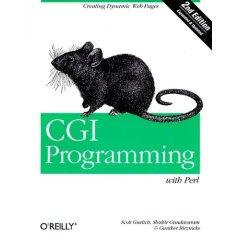| 2020ok Directory of FREE Online Books and FREE eBooks |
Free eBooks > Computers & Internet > Web Development > Internet Applications > Email > CGI Programming With Perl 5
CGI Programming With Perl 5by Gunther Birznieks, Scott Guelich, and Shishir Gundavaram  Download Book If you are the author or the publisher, and would like to link to your site here, please contact us. About Book Amazon.com The appearance of the second edition of CGI Programming with Perl heralds the beginning of the neoclassical era of Web service. CGI--or common gateway interface--is the original back end for client-driven, dynamic Web-page service and deserves consideration as the Romulus of the Internet Empire. But, where first-edition author Gundavaram described the lonely Romulus laying the brick foundation of dynamic Web-page service in 1996, second-edition collaborators Guelich and Birznieks have pitched in to resurrect Romulus amid the crowded streets of modern Rome. Why bother? Surely four years have brought technological revolutions (Java, PHP, ASP, ColdFusion) that render CGI's original brick-by-brick approach as obsolete as, say, Roman mythology--or bricks and mortar. And yet not. It is an ambiguous blessing that the original CGI persists, adhering to the underside of Web service by the duct tape that is Perl. This point is not missed by Guelich, Gundavaram, and Birznieks, whose advocacy of CGI is both bolstered by the growing applications module base of Perl and tempered by their awareness of CGI's structural limitations. Both new and returning readers of CGI Programming with Perl should browse the last chapter first in order to appreciate the proposed solutions to CGI's greatest sin: its impractical slowness in a world of a million-hits-per-day Web service. The chapter describes CGI-compatible FastCGI and mod_perl technologies that circumvent the process-spawning slowness of the simple CGI. Advanced users might want to skip directly to O'Reilly's fine mod_perl tome, Writing Apache Modules with Perl and C, by Lincoln Stein and Doug MacEachern. The authors' second pass at CGI pedagogy is a lucid, honest, and expanded account that develops functionality of dynamic Web pages in a rational progression--from HTML client-server and CGI syntax basics to general input/output, forms, e-mail, graphics, and simple database applications, including maintaining client state and data persistence under the otherwise stateless HTTP protocol. The authors offer synopses of cookies, JavaScripting, server security, and XML, all of which are described in detail in other books. Whether or not neoclassical CGI is fast enough for your purposes--perhaps for guarded intranets--bear in mind that CGI is the standard to which every other Web server has had to respond. The second edition of CGI Programming with Perl is still the best introduction to the classics. --Peter Leopold
Book Info Shows how to use CGI to deliver dynamic content on websites. Demonstrates current techniques available with the CGI.pm module and the latest versions of Perl. Explains how CGI and the underlying HTTP protocol work, and then moves quickly into the important details of developing CGI programs. Previous edition: c1996. Softcover. Related Free eBooks
| Related Tags |












SEND A COMMENT
PLEASE READ: All comments must be approved before appearing in the thread; time and space constraints prevent all comments from appearing. We will only approve comments that are directly related to the article, use appropriate language and are not attacking the comments of others.